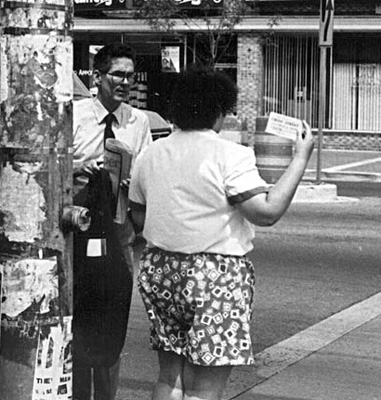

By interviewing 72 people passing or helping a deaf-blind person, we found some answers.
Survey Method & Design
Two different sessions were held. In each session, a deaf-blind man or a deaf-blind woman stood at a corner, holding up one of the cards shown below to solicit aid to cross the street.
Below, card on the left is called the "HKNC Card", on the right is the "Experimental Card"


Three interviewers waited at strategic locations, ready to interview people who passed by or guided the deaf-blind person across.
After getting assistance to cross, the deaf-blind person entered a nearby store, waited a few minutes while the interviews were completed and the sidewalk cleared, then approached the corner to solicit aid to cross back again.
Click here for the questions asked of the passersby

Survey Results
Guide's Awareness
table test
Guide's Awareness
|
Experimental card
|
HKNC Card
|
Total
|
|
|
Guide's awareness of hearing impairment
|
|||
|
Didnít realize person was deaf
|
5
|
4
|
8
|
|
Knew person was deaf
|
11
|
9
|
20
|
|
TOTAL
|
16
|
13
|
29
|
|
Reasons that passersby knew person was deaf
|
|||
|
Saw the words "deaf" or "tap me" on the card
|
7
|
4
|
11
|
|
Person didn't respond when spoken to
|
0
|
3
|
3
|
|
Person signed while speaking
|
0
|
1
|
1
|
|
Person said he is deaf*
|
1
|
0
|
1
|
|
Person's voice sounded unusual*
|
1
|
1
|
2
|
|
There was no response to their offer for assistance, then they read the card further
|
2
|
0
|
2
|